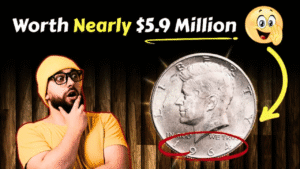Ever toss a penny into a jar without a second thought? You might want to start checking your change! Some Lincoln Wheat Pennies, minted from 1909 to 1958, are worth over $1 million due to rare errors and low mintages.
These tiny copper coins, still occasionally found in circulation, carry a piece of American history and could turn your loose change into a fortune. Ready to hunt for treasure? Let’s explore the most valuable Lincoln Wheat Pennies and how to spot them in your pocket change.
What Are Lincoln Wheat Pennies?
Lincoln Wheat Pennies, often called “Wheat Cents,” were first minted in 1909 to honor Abraham Lincoln’s 100th birthday. Designed by Victor David Brenner, they feature Lincoln’s profile on the front and two wheat stalks on the back—hence the nickname.
Most were made of copper, except during World War II when copper shortages led to steel or zinc-coated versions. While billions were produced, certain rare varieties and errors make some pennies incredibly valuable.
Why Are Some Wheat Pennies So Valuable?
A penny’s value hinges on rarity, condition, and historical significance. Rare minting errors, like using the wrong metal or double stamping, create one-of-a-kind coins. Low-mintage years from mints like San Francisco or Denver also drive up value.
Coins in “mint state” (near-perfect condition) are worth far more, as most pennies show wear after decades in circulation. Let’s look at the top four that could make you rich.
Top 4 Most Valuable Lincoln Wheat Pennies
Here are the rarest and most sought-after Lincoln Wheat Pennies that could still be hiding in your change:
1. 1909-S VDB Penny
The 1909-S VDB is a collector’s dream. Minted in San Francisco (“S” mint mark) with only 484,000 produced, it features the designer’s initials “VDB” on the reverse near the wheat stalks. In top condition, one sold for over $1 million! Check for the “S” under the date and tiny “VDB” on the back. These are rare but occasionally turn up in old collections.
2. 1943 Bronze Penny
During World War II, pennies were made of steel to save copper, but a few 1943 pennies were accidentally struck in bronze. With only about 20 known to exist, these are worth up to $1.7 million in pristine condition. Check your 1943 pennies—if it’s brownish-red and doesn’t stick to a magnet, you might have a winner!
3. 1955 Doubled Die Penny
This penny has a striking error where the date and “LIBERTY” appear doubled due to a misaligned minting die. The blurry effect is noticeable with a magnifying glass. In good condition, these can fetch $25,000 or more. They were minted in Philadelphia (no mint mark), so they’re prime candidates for circulation finds.
4. 1914-D Penny
Minted in Denver (“D” mint mark) with a low mintage of 1.2 million, the 1914-D penny is highly sought after. In high-grade condition, it can sell for $100,000 or more. Look for the “D” under the date and check for sharp details and minimal wear.
Value Table for Rare Lincoln Wheat Pennies
Here’s a quick reference for their approximate values:
| Year & Variety | Mint Mark | Estimated Value | Why It’s Valuable |
|---|---|---|---|
| 1909-S VDB | S | $700–$1 million+ | Low mintage, designer’s initials |
| 1943 Bronze | Any | $100,000–$1.7 million | Rare bronze error during steel production |
| 1955 Doubled Die | None | $1,000–$25,000+ | Noticeable doubled text error |
| 1914-D | D | $500–$100,000+ | Low mintage, high-grade rarity |
How to Spot a Valuable Wheat Penny in Circulation
Think you’ve found a rare penny? Here’s how to check:
- Check the Date and Mint Mark: Look under the date for an “S” (San Francisco), “D” (Denver), or no mark (Philadelphia). Key years include 1909, 1914, 1943, and 1955.
- Test for Bronze (1943): Use a magnet—steel pennies stick, bronze ones don’t. Bronze pennies are brownish-red, not silver-colored.
- Look for Errors: Use a magnifying glass to spot doubled text (1955) or the “VDB” initials (1909-S VDB).
- Assess Condition: Pristine coins with sharp details and no scratches are worth more. Avoid cleaning, as it damages value.
- Get It Graded: Professional grading by PCGS or NGC confirms authenticity and boosts value.
Tips for Protecting Your Pennies
Found a potential gem? Handle it with care:
- Don’t Clean: Cleaning removes the natural patina, lowering value.
- Store Safely: Use acid-free plastic holders or coin flips to prevent scratches.
- Handle Gently: Use gloves or tweezers to avoid fingerprints or damage.
- Get Expert Advice: Take it to a reputable coin dealer or grading service like PCGS or NGC for authentication.
Real-Life Examples of Million-Dollar Pennies
- 1943 Bronze Penny: Sold for $1.7 million in 2010 due to its extreme rarity.
- 1909-S VDB: A pristine example fetched $168,000 at auction for its low mintage and historical significance.
- 1955 Doubled Die: A high-grade version sold for $124,000, thanks to its dramatic error.
How to Sell Your Rare Penny
If you think you’ve found a valuable Wheat Penny:
- Compare Features: Use resources like PCGS or Heritage Auctions to match your coin’s traits.
- Authenticate It: Get it graded by PCGS or NGC to confirm its condition and authenticity.
- Sell Smart: High-value coins do best at auction houses like Heritage Auctions or Stack’s Bowers. For common coins, try local coin shops or eBay.
Why Hunt for Lincoln Wheat Pennies?
Searching for rare Lincoln Wheat Pennies is a thrilling mix of history and treasure hunting. These coins connect us to America’s past, from Lincoln’s legacy to World War II sacrifices. Finding one in your change is like striking gold—and it could be worth millions! So, next time you get a penny, give it a closer look. Your pocket change might just change your life.
FAQs About Lincoln Wheat Pennies
Q: Why are some Lincoln Wheat Pennies so valuable?
A: Rarity, minting errors (like the 1943 bronze or 1955 doubled die), low mintages (like 1909-S VDB), and pristine condition drive their value, with some worth over $1 million.
Q: How can I tell if my 1943 penny is bronze?
A: Check the color (bronze is brownish-red, not silver) and test with a magnet—bronze won’t stick, steel will.
Q: Which Lincoln Wheat Pennies are most valuable?
A: Look for the 1909-S VDB ($700–$1 million+), 1943 Bronze ($100,000–$1.7 million), 1955 Doubled Die ($1,000–$25,000+), and 1914-D ($500–$100,000+).
Q: Can I still find rare Wheat Pennies in circulation?
A: Yes, though rare, these pennies can still appear in pocket change, old jars, or collections.
Q: Where can I sell a rare Lincoln Wheat Penny?
A: High-value coins sell best at auction houses like Heritage Auctions or Stack’s Bowers. Common coins can go to local coin shops or eBay.
Q: Should I clean my penny to make it shinier?
A: No, cleaning damages the coin’s patina and lowers its value. Keep it untouched and consult a professional.




